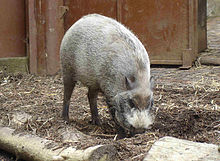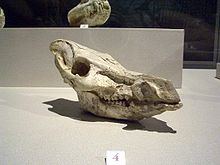Suidae
[1] Several fossil species are known and show adaptations to a wide range of different diets, from strict herbivory to possible carrion-eating (in Tetraconodontinae).
Unlike most other members of the order, they have four hooves on each foot, although they walk only on the middle two digits, with the others staying clear of the ground.
[citation needed] The males possess a corkscrew-shaped penis, which fits into a similarly shaped groove in the female's cervix.
[5][6][7] Suids have a well-developed sense of hearing, and are vocal animals, communicating with a series of grunts, squeals, and similar sounds.
The canine teeth are enlarged to form prominent tusks, used for rooting in moist earth or undergrowth, and in fighting.
In practice, however, male suids are unlikely to gain access to sows in the wild until they have reached their full physical size, at around four years of age.
† Mabokopithecus † Hemichoerus † Paradoxodonides † Cainochoerus † Chleuastochoerus † Dubiotherium † Sinapriculus † Hyotherium † Listriodon † Lopholistriodon † Eurolistriodon † Bunolistriodon † Nguruwe ?
† Kenyasus † Libycochoerus † Megalochoerus † Kubanochoerus † Miochoerus † Conohyus † Tetraconodon † Parachleuastochoerus † Lophochoerus † Sivachoerus † Nyanzachoerus † Notochoerus † Namachoerus † Korynochoerus † Hippopotamodon † Eumaiochoerus † Microstonyx Sus sensu stricto Porcula ?


